LAB REPORT
Science and Technology Making Headlines
June 28, 2019

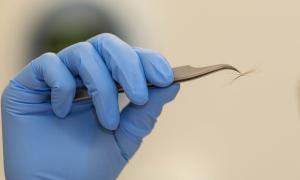
Livermore graduate scholar and chemist Fanny Chu is part of a team that found that any single hair from anywhere on the human body can be used to identify a person. Photo by Julie Russell/LLNL
It’s a hairy situation
A new forensic technique could help identify perpetrators of sexual assault using a kind of evidence typically deemed unreliable by the scientific community: hair.
A recent breakthrough from Lawrence Livermore National Laboratory could provide the forensic community with a new quantitative method to identify perpetrators based on a single human hair from anywhere on the body. The findings build on previous research that allowed LLNL scientists to identify a person from a human hair based on the information contained in its proteins, which are more durable than DNA and can tell a scientist about mutations in the DNA itself.
“The drive is to get away from subjective kinds of analyses,” said Deon Anex, group leader at the Forensics Science Center at LLNL (Anex credited chemist Fanny Chu, a Livermore graduate scholar, with the majority of the study's findings.) What the group’s new technique would offer, he said, is a way of analyzing hair samples that would not rely on any scientist’s opinion, how many years of experience they have or their persuasiveness in court.

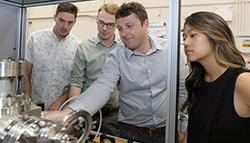
Lawrence Livermore National Laboratory researchers (from left) Phil Depond, Nick Calta, Aiden Martin and Jenny Wang.
X marks the spot of metal defects
Scientists at Lawrence Livermore National Laboratory, SLAC National Accelerator Laboratory and Ames Laboratory are researching X-ray imaging to examine metal parts during the laser powder-bed fusion process. The research is part of a partnership between the laboratories to identify the causes of defects in metal 3D-printed parts and understand how those flaws can be mitigated.
To carry out the project, LLNL researcher Nick Calta and his team have designed a portable diagnostic machine capable of probing the metal 3D-printing process using X-ray imaging. The machine ultimately helped provide researchers with new insights into the metal additive manufacturing process. “A vast majority of diagnostics use visible light, which are extremely useful but also limited to analyzing the surface of the part,” Calta said.
“If we’re going to really understand the process and see what causes flaws, we need a way to penetrate through the sample,” he said. “This instrument allows us to do that.”
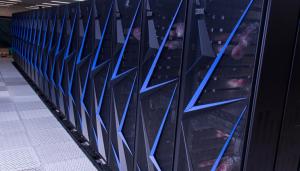
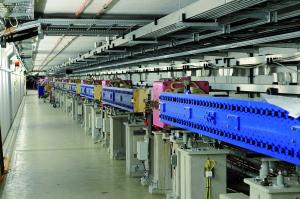
The extremely bright third-generation X-ray source PETRA III at DESY was used to compress samples faster than any similar device.
Feeling the squeeze
A new super-fast high-pressure device at DESY's X-ray light source allows scientists to simulate and study earthquakes and meteorite impacts more realistically in the lab.
The new-generation dynamic diamond anvil cell (dDAC), developed by scientists from Lawrence Livermore, DESY, the European Synchrotron Radiation Source ESRFand the universities of Oxford, Bayreuth and Frankfurt/Main, compresses samples faster than any similar devices. The instrument can turn up the pressure at a record rate of 1.6 billion atmospheres per second and can be used for a wide range of dynamic high-pressure studies.
The developers said their new device has already proven its capabilities in various materials experiments.
“For more than half a century the diamond anvil cell or DAC has been the primary tool to create static high pressures to study the physics and chemistry of materials under those extreme conditions, for example to explore the physical properties of materials at the center of the Earth at 3.5 million atmospheres,” said lead scientist Zsolt Jenei from LLNL.

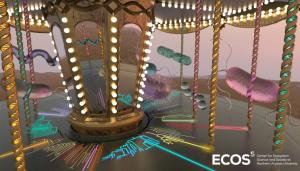
In this microbial merry-go-round, the velocity of each bacterial cell indicates its relative growth rate: faster for those posted near the edge of the spinning carousel, and slower for those stationed toward the center, with the various positions rooted in place by the bacterial tree of life. Image by Victor Leshyk/Northern Arizona University
Nature vs. nurture
When it comes to soil microorganisms, how much of their life's work is driven by nature versus nurturing in their current environment?
As it turns out, the evolutionary history of soil microorganisms plays a larger role in growth rates and carbon uptake, according to a new study by Lawrence Livermore researchers and collaborators.
“Our results suggest that, similar to multicellular organisms, the traits of soil bacteria in their natural habitats are constrained by evolutionary history to a greater degree than environmental variation," said LLNL biologist Jennifer Pett-Ridge, a co-author on the paper.
In the research, a team of microbial ecologists studied soil microorganisms in systems ranging from conifer forests to a high desert grassland. They found that the growth rate and carbon uptake of individual microbial populations was directly related to aspects of their genomes that reflect evolutionary relationships, much like a family tree can track similar traits among family members.

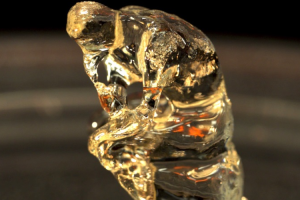
Researchers created a miniature replica of “The Thinker” using new 3D printing method.
Let there be light
A research team from LLNL and UC Berkeley developed a completely new approach to 3D printing. Dubbed computed axial lithography (CAL), this method utilizes volumetric printing technologies instead of relying on the traditional layer-by-layer mechanisms.
The team demonstrated the process using a miniature replica of Auguste Rodin’s iconic “The Thinker” sculpture. Inspired by how CAT scans work, the team used tomography to capture a series of images of the replica from every angle. They stitched these images together to create a video, which was then fed into a digital light processing (DLP) projector.
The images were projected via light onto a rotating jar of a photopolymer, a type of resin that transforms its properties when exposed to certain amounts of certain kinds of light. Once activated by the light, the resin began to cure in the shape of The Thinker replica.
Unlike other forms of additive manufacturing, this method allowed researchers to print objects in their entirety at once, which not only sped up the process but also improved the aesthetic by removing the ridged effect that layer-by-layer construction sometimes leaves behind.


This panorama of the Lawrence Livermore National Laboratory was taken from its southwest corner, showing much of the one-square-mile campus.
Lab Report takes a break
The Livermore Lab Report will take a break for the Fourth of July holiday. It will return July 12.





